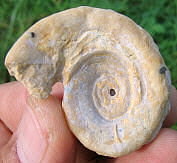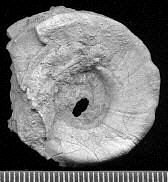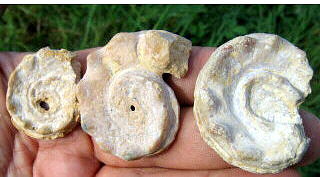Euomphalus moniliferus Romanovsky
Click on pictures to magnify
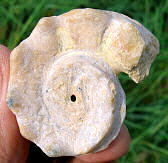

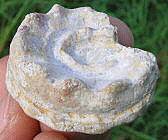
Euomphalus
moniliferus Romanovsky
Discussion:
This large and flattened gastropod is recognized by
its flat coiled
(planispiral) shell, thick shell wall and large nodes on one side of the
shell. It is common in shallow water deposits of the late Carboniferous
and early Permian. The shell wall contains a thick outer layer of calcite
along with an inner layer of aragonite and the calcite provides for
better preservation than is typical for molluscs. Molluscs with an
aragonitic shell are either poorly preserved or lost in ancient
sediments because the aragonite is dissolved away. Euomphalus
and other calcitic shelled gastropods preserve nearly as well as
brachiopods, bryozoans and echinoderms.
These large euomphalids have large nodes on one side
of the whorl,
but the other side is flat. The margins of the whorl have 90 degree
angled corners and the shell is different on the two sides. There is
a constriction on the middle of the outer rim and the shell is thinner
and weaker there. On some specimens this is a zone of breakage
if the aragonitic inner layer of the shell has dissolved away, where
the top part of the shell breaks and slides down over the bottom
part. The difference probably relates to life habits. The gastropod
is believed to lay stationary on the seafloor most of the time, feeding
as a suspension feeder. The flat side gave it stability and the thick
shell protected the animal from shell crushing predators. Note the
breakage of the center of the coil, where the first-formed shell tends
to break away because it is so thin.
Go-Back
Phylum
Mollusca (clams
- gastropods - cephalopods)
Fossil
Menu
Site
Search Engine
search Carboniferous fossils of Russia or the Web
